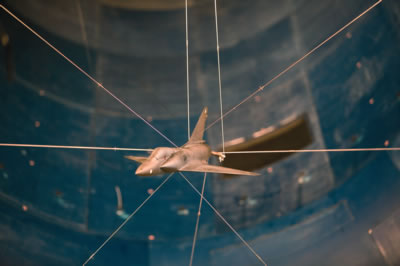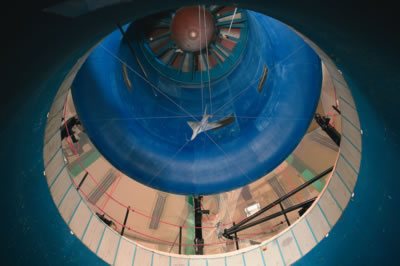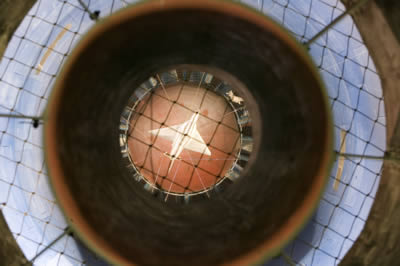If there is a question of a wind instrument in the Sacso project, it is not a matter of music but of flight mechanics and aerodynamics. Sacso designates a very particular model testing mechanism in a wind tunnel, dedicated to predicting the behavior of aircraft in flight.

Photo Patrick Galabert - © ONERA 2006
Model of combat aircraft suspended in the vertical wind tunnel at Lille (DCSD)
Contrary to the traditional setup where the model is fixed to the wall by some rigid device (sting, mast, or other), here it is suspended and driven in motion in the flow by nine cables, with controlled tension. Recent robotics techniques are used to control the system, namely "hybrid force-position control of parallel redundant kinematics."
This mechanism is currently dimensioned for the low-velocity domain (0-35 m/s) and is installed in Onera's vertical wind tunnel in Lille .

Photo Patrick Galabert - © ONERA 2006
The vertical wind tunnel in Lille with the Sacso setup in the center of the test section
The main functionalities are:
- to generate model motions in six degrees of freedom (three translational directions and three rotational axes), which makes it possible to reproduce certain flight path phases. The model can also be driven in simple elementary motions, which is particularly interesting for developing mathematical models of behavior.
- to simulate free flight, so that the couplings can be studied between the aircraft or control surface motions and aerodynamics (that is, the loads of the air in motion on the surface of the aircraft).


Photo Patrick Galabert - © ONERA 2006
The open test section of the vertical wind tunnel and its control center
The model's flight mechanics parameters (positions, velocities, accelerations) are reconstructed from data internal to the model (acceleration and speed of rotation measurements), optical flight path tracking and model attitudes, the cable lengths. Aerodynamical loads are calculated from the known linking forces and moments between the suspension and the model itself, measured by a six-component balance.
In short, Sacso allows us to study flight mechanics under wind tunnel experimental conditions: the model can have a free dynamic behavior and all the flight parameters can be known or imposed at will. This is what makes Sacso unique.

Photo Patrick Galabert - © ONERA 2006
The Sacso setup seen from the bottom of the wind tunnel.
Texte : D. Farcy, S. Gaultier
Sacso : P. Carton, C. Lambert, D. Farcy , M. Llibre




